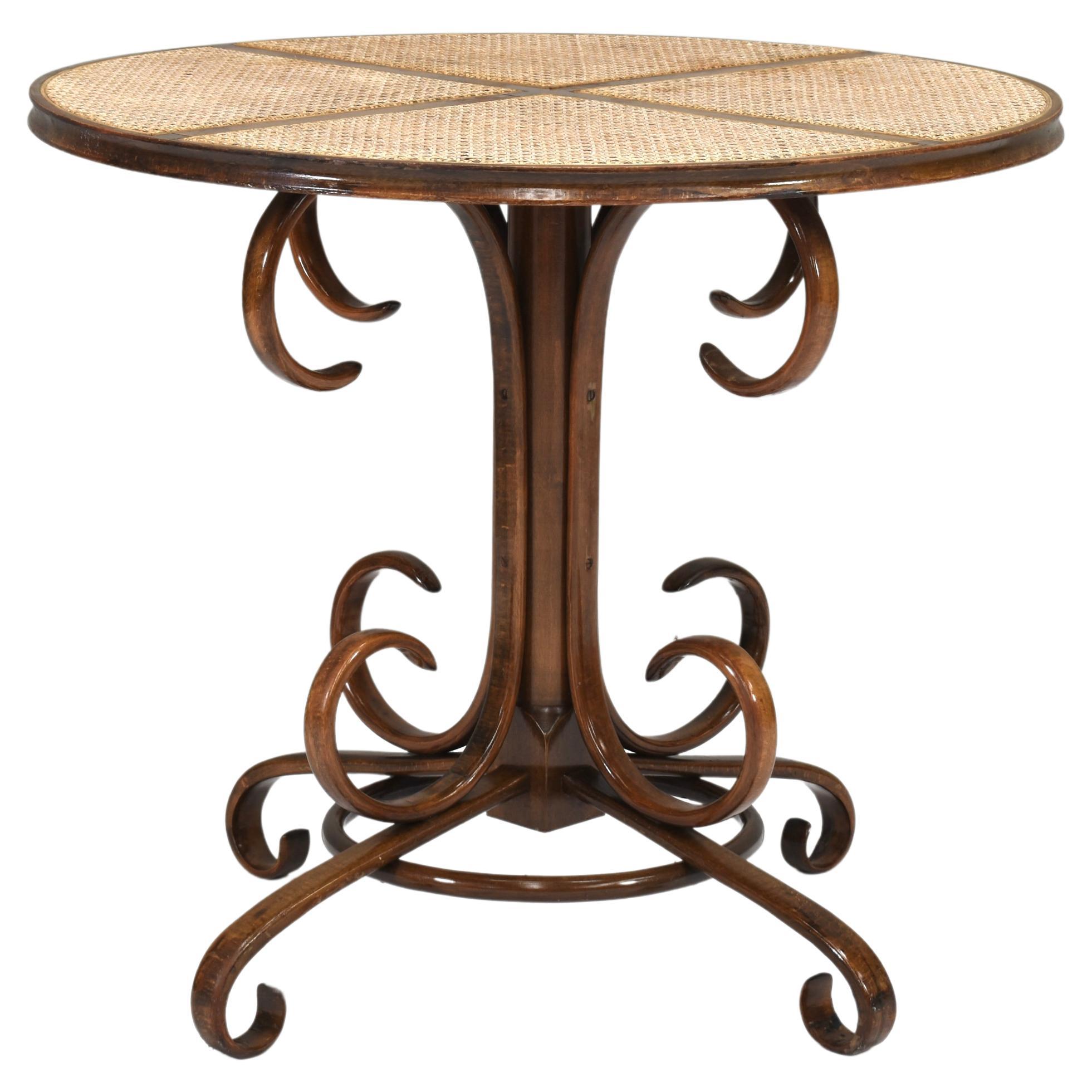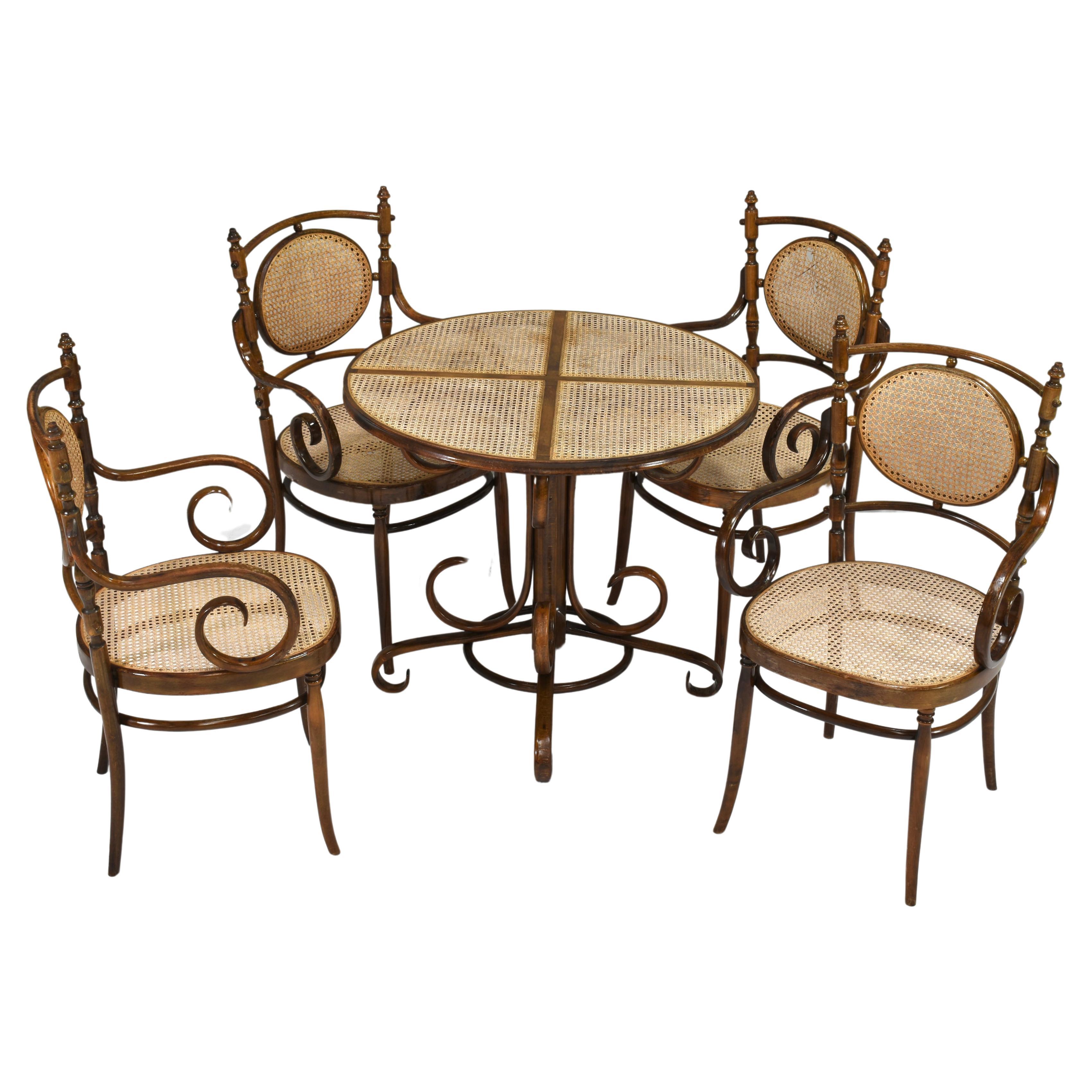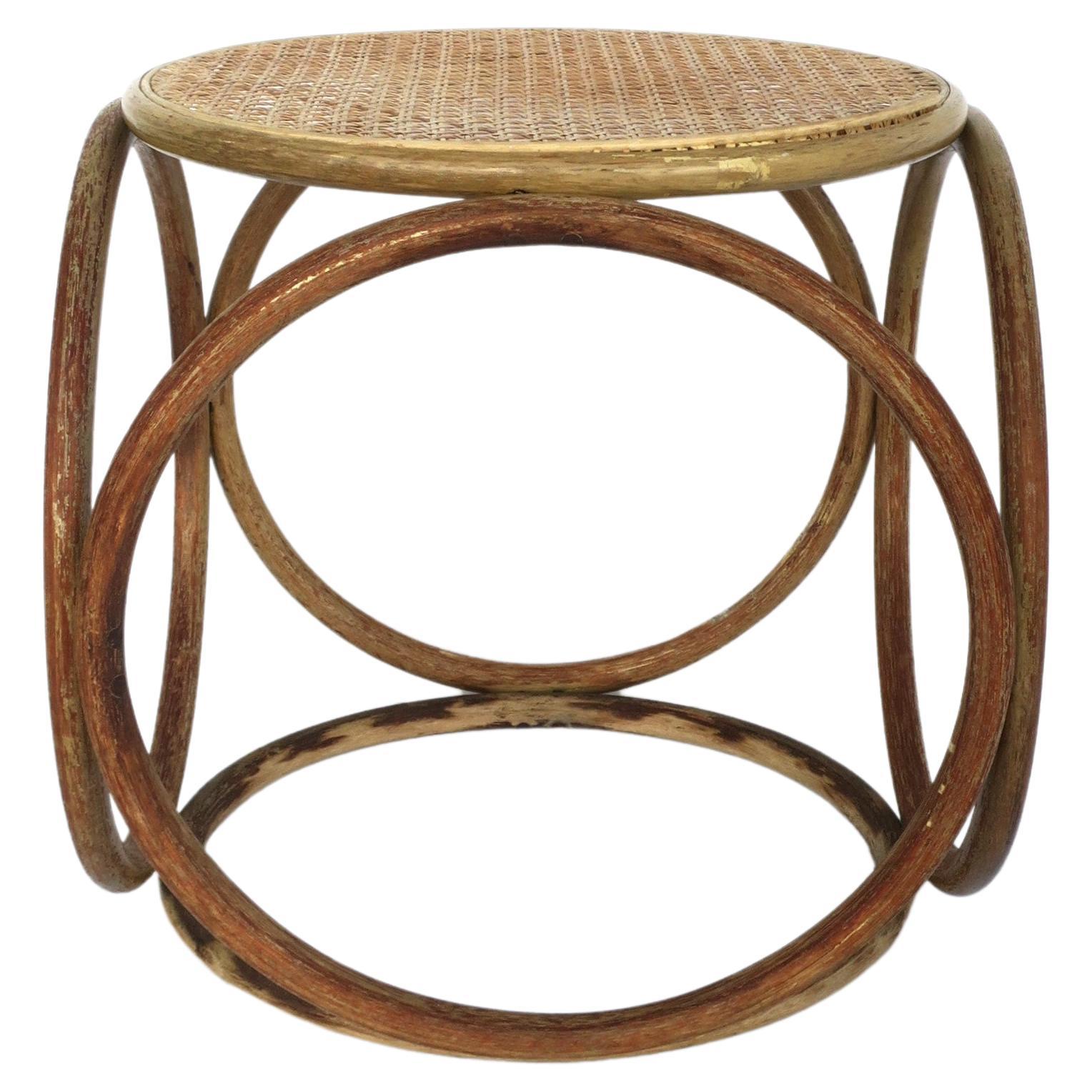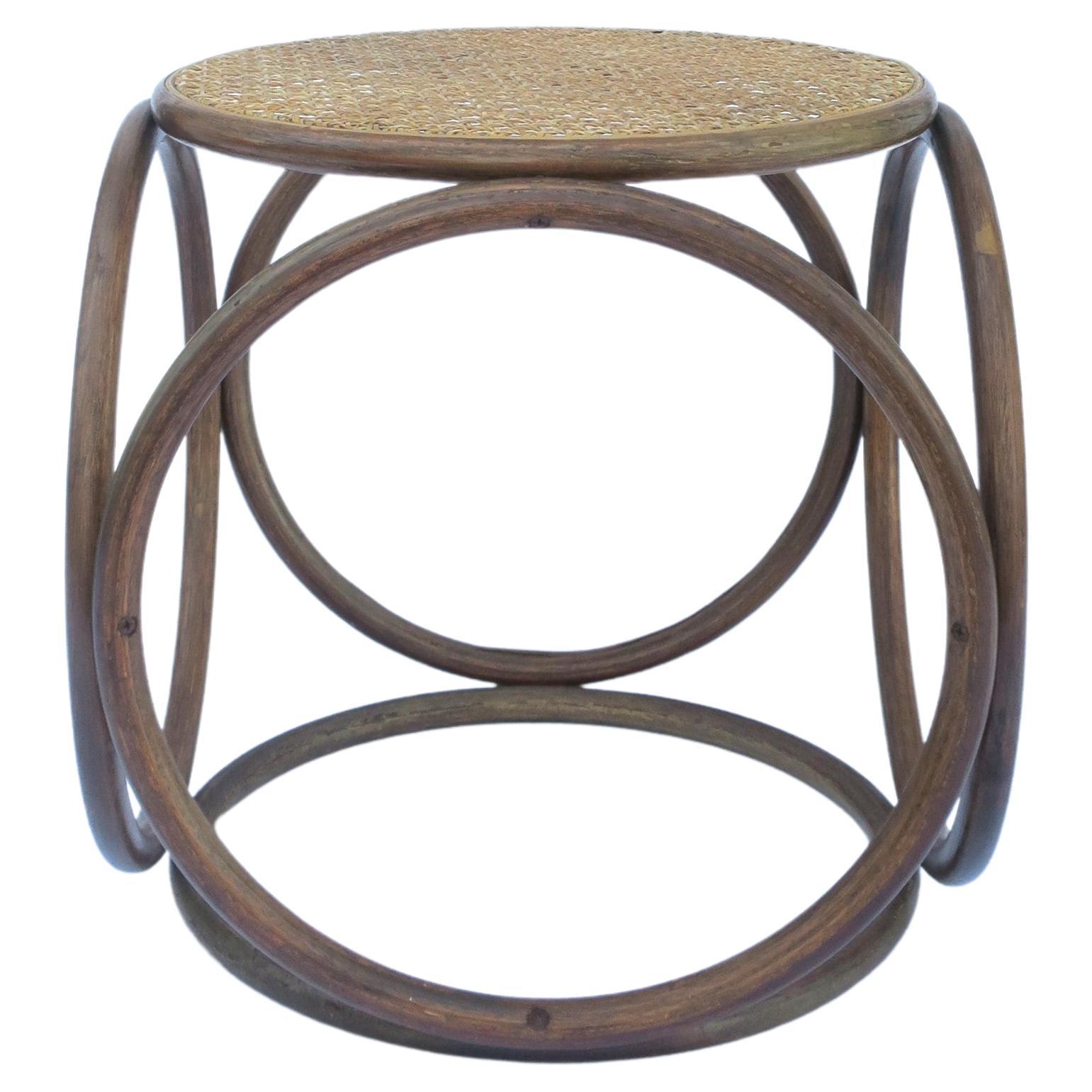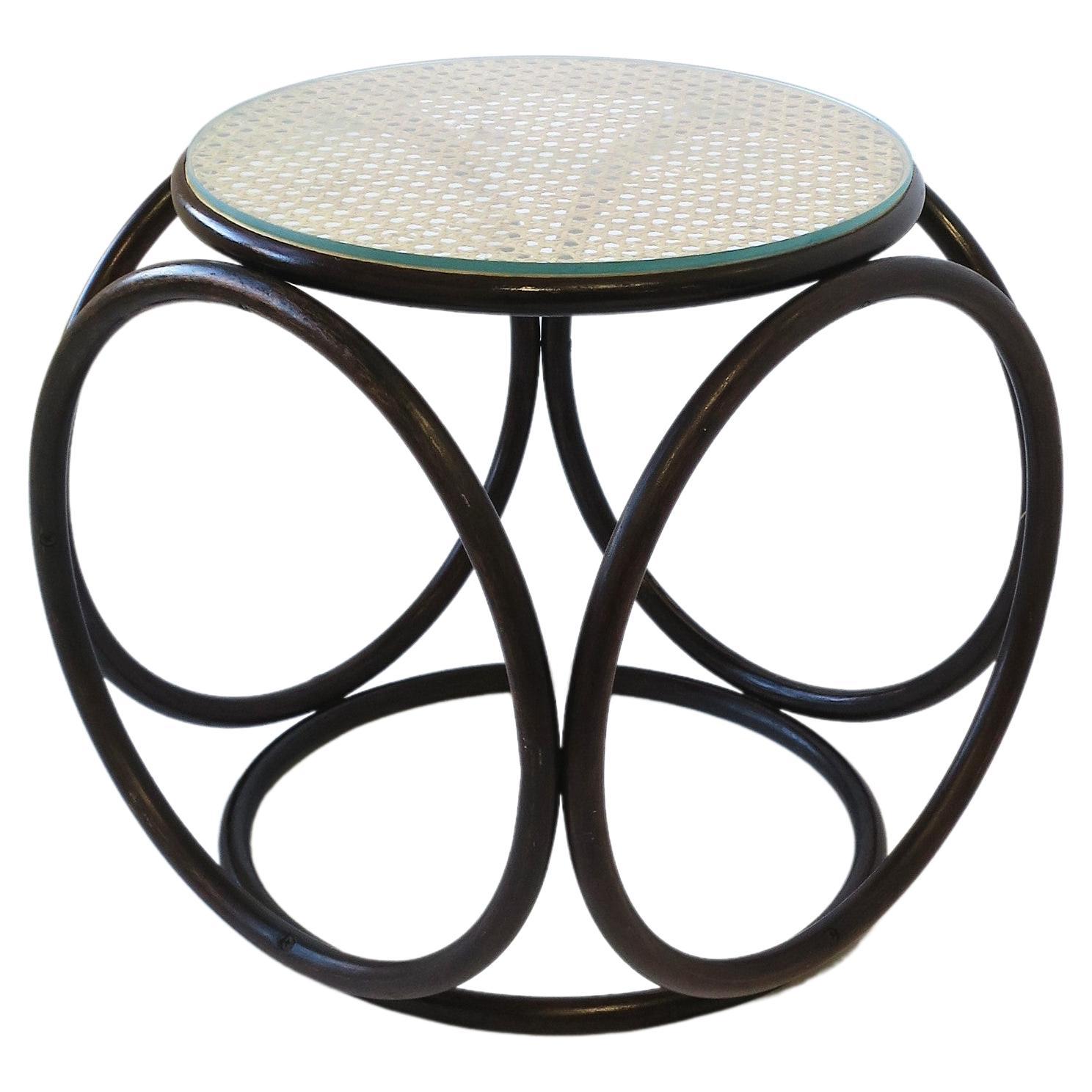Items Similar to 2 Michael Thonet Bentwood Cane Stool Ottoman Side Table End Table Rustic Austria
Want more images or videos?
Request additional images or videos from the seller
1 of 15
2 Michael Thonet Bentwood Cane Stool Ottoman Side Table End Table Rustic Austria
About the Item
Pair of Michael Thonet attributed classic and timeless Mid-Century Modern bentwood and cane stool, ottoman, side table, drinks table or end table made in Europe, Austria.
All rustic handwoven bentwood and wicker cane top stool or side drinks table.
Fully restored and the pair works perfect as a side, drinks table or stool.
Rustic European Design built to last.
- Attributed to:Michael Thonet (Designer)
- Similar to:Thonet (Manufacturer)
- Dimensions:Height: 15.5 in (39.37 cm)Width: 15.5 in (39.37 cm)Depth: 15.5 in (39.37 cm)
- Sold As:Set of 2
- Style:Bohemian (Of the Period)
- Materials and Techniques:
- Place of Origin:
- Period:
- Date of Manufacture:1959
- Condition:Refinished. Wear consistent with age and use. The Thonet Style side tables are fully restored and ready for use. Documented in the pictures.
- Seller Location:Miami, FL
- Reference Number:
About the Seller
5.0
Platinum Seller
These expertly vetted sellers are 1stDibs' most experienced sellers and are rated highest by our customers.
Established in 2001
1stDibs seller since 2010
658 sales on 1stDibs
Typical response time: 1 hour
- ShippingRetrieving quote...Ships From: Miami, FL
- Return PolicyA return for this item may be initiated within 7 days of delivery.
More From This SellerView All
- 1 Bohemian Greek Key Pattern Handcrafted Bamboo & Cane Folding Side Drink TableLocated in Miami, FL1960s Single Bohemian style Mid-Century Modern handcrafted bamboo and cane square folding Side, Drink or End Table. Strands of Bamboo in geometric shapes on Top and the Apron is deco...Category
Vintage 1960s American Bohemian Side Tables
MaterialsBamboo, Cane
- Modern Two-Tier Clear Acrylic and Crystallized Acrylic Side Table, End TableLocated in Miami, FLModern one inch thick two-tier clear Acrylic side table or end table. The top and base are having chiseled details that appear like crystalliz...Category
2010s American Modern Side Tables
MaterialsLucite
- Chinoiserie Bamboo & Rattan Handmade Two-Tier Side, End Table Asian Modern 70sLocated in Miami, FLVintage Chinoiserie bamboo and rattan handmade two-tier side table, end table in Asian Modern style.Category
Vintage 1970s Asian Chinoiserie Side Tables
MaterialsBamboo, Rattan
- Brass & Tessellated Stone on Bamboo Wood Side, Drink, End Table Maitland SmithBy Maitland SmithLocated in Miami, FLWe offer a Maitland-Smith Style Mid-Century Modern round side, drink, end table made out of a Bend Bamboo Tripod Base with a Tessellated Stone over Wood Top. The Stone Top has an in...Category
Late 20th Century Philippine Mid-Century Modern Side Tables
MaterialsStone, Brass
- 1970 Machine Age Heavy Turquoise Finished Coil Shape Column Side End Drink TableLocated in Miami, FLRound Machine Age Industrial Coil Cylinder shaped heavy Steel Drink table, Side Table or End Table. Mid-Century Modern Space Age Column in Turquoise Teal Paint Finish to display Yo...Category
Late 20th Century American Machine Age Side Tables
MaterialsSteel
- 1970 French Style Bend Steel Round Glass Top End Side Drink Table Brass FinialBy Maison JansenLocated in Miami, FLMid-Century Modern French Maison Jansen Style Bend Steel Side, End or Drink Table with round Glass Top insert. Brass Finial Decor at the Center where the sculptural Base and Top fra...Category
Late 20th Century American Mid-Century Modern End Tables
MaterialsBrass, Steel
You May Also Like
- Early Michael Thonet Bistro Dining Table in Bentwood and Cane - AustriaBy Thonet, Michael ThonetLocated in Pijnacker, Zuid-HollandBistro dining table in bentwood and cane designed by Michael Thonet. Originally designed in the 1860s and produced by Thonet in the 20th century by multiple factories. Size: chairs: 57x49x96.5 seat height 46 Arm height 67 centimeter table: ø85.5 height 75 centimeter Condition: used. The lacquer has worn out on some places. The stained beech wood has discoloration. Cane in the table top is good. The cane in two seats is damaged. The cane in one back is damaged. One arm has a crack in a curve. Some small wood details are missing. The cane can be repaired or replaced professionally on request. Michael Thonet The development of bentwood for use in furniture is one of history’s most significant innovations in design. A range of renowned mid-century modern designers such as Alvar Aalto, Arne Jacobsen, and Charles and Ray Eames drew heavily on this technological advancement, and the success of their enduring works owes to the efforts of pioneering German-Austrian industrialist and designer Michael Thonet — founder of Thonet and widely considered the father of bentwood furniture. Bentwood furniture dates as far back as the Middle Ages, but it is the 19th-century cabinetmaker and master of parquetry Michael Thonet who is most often associated with this now-classic technique. Thonet in 1856 patented a method for bending solid wood through the use of steam, and from there, the bentwood look skyrocketed to furniture fame. He experimented with bending birch rods into rounded shapes — forming delicately seductive, curving Art Nouveau creations that were a daring departure from the heavy, hand-carved designs attributed to his contemporaries. The Boppard-born Thonet honed his carpentry skills in his father’s workshop, where he carried out experiments with plywood and modified the Biedermeier chairs that populated the studio. He received an invitation from Austrian Chancellor Prince Metternich to contribute Neo-Rococo interiors to the Liechtenstein City Palace in Vienna. From there, the cabinetmaker gained international recognition, including at London’s Great Exhibition of 1851, which featured works created by members of the Arts and Crafts movement as well as industrial products. Thonet showed a range of furniture at the fair and won the bronze medal for his bentwood chairs. He incorporated his family’s company, the Thonet Brothers — or Gebrüder Thonet — with his sons in 1853. Considered the world’s oldest mass-produced chair, Michael Thonet’s ubiquitous Chair No. 14 demonstrated that his patented bentwood technology made it possible to efficiently produce furniture on an industrial scale. Often called the Coffee House chair — the company’s first substantial order was for a Viennese coffeehouse — the No. 14 remains an icon. Thonet originally designed the chair in 1859, and it is considered the starting point for modern furniture. Composed of just six parts, the chair, with its simple, lightweight design, belies its durability. The No. 14 was followed by the No. 18, or the Bistro chair, in 1867, and the 209, or the Architect’s chair, of which Le Corbusier was a fan. (The influential Swiss-French architect and designer used Thonet furniture in his Pavillon de l’Esprit Nouveau at the 1925 International Exposition of Decorative Arts in Paris.) The business began mass-producing furniture. By the end of the 1850s, there were additional Thonet workshops in Eastern Europe and hundreds of employees. Michael Thonet’s reputation attracted the attention of notable architects including Otto Wagner, Marcel Breuer and Ludwig Mies van der Rohe. Thonet’s patented bentwood technology also yielded an improvement to rocking chairs for his company — in the middle of the 19th century, Michael produced a series of rockers in which the different curved parts were integrated into fluid, sinuous wholes. Thanks to Thonet, the humble rocker acquired something unexpected: style. And bentwood furniture was embraced by a series of design greats — the innovation can be found in the seating that Josef Hoffman designed for Thonet, in the elegant Superleggera chair created by Gio Ponti and Alvar Aalto’s expressive Paimio armchair...Category
Antique 1860s Austrian Rococo Revival Dining Room Tables
MaterialsCane, Bentwood
- Early Michael Thonet N.17 Bistro Dining Set in Bentwood and Cane - AustriaBy Michael Thonet, ThonetLocated in Pijnacker, Zuid-HollandNo. 17 dining set in bentwood and cane 'long john' chairs and table designed by Michael Thonet. Originally designed in the 1860s and produced by Thonet in the 20th century by multiple factories. Size: chairs: 57x49x96.5 seat height 46 Arm height 67 centimeter table: ø85.5 height 75 centimeter Condition: used. The lacquer has worn out on many places. The stained beech wood has discoloration. The cane in two seats is damaged. The cane in one back is damaged. One arm has a crack in a curve. Some small wood details are missing. The cane can be repaired or replaced professionally on request. Michael Thonet The development of bentwood for use in furniture is one of history’s most significant innovations in design. A range of renowned mid-century modern designers such as Alvar Aalto, Arne Jacobsen, and Charles and Ray Eames drew heavily on this technological advancement, and the success of their enduring works owes to the efforts of pioneering German-Austrian industrialist and designer Michael Thonet — founder of Thonet and widely considered the father of bentwood furniture. Bentwood furniture dates as far back as the Middle Ages, but it is the 19th-century cabinetmaker and master of parquetry Michael Thonet who is most often associated with this now-classic technique. Thonet in 1856 patented a method for bending solid wood through the use of steam, and from there, the bentwood look skyrocketed to furniture fame. He experimented with bending birch rods into rounded shapes — forming delicately seductive, curving Art Nouveau creations that were a daring departure from the heavy, hand-carved designs attributed to his contemporaries. The Boppard-born Thonet honed his carpentry skills in his father’s workshop, where he carried out experiments with plywood and modified the Biedermeier chairs that populated the studio. He received an invitation from Austrian Chancellor Prince Metternich to contribute Neo-Rococo interiors to the Liechtenstein City Palace in Vienna. From there, the cabinetmaker gained international recognition, including at London’s Great Exhibition of 1851, which featured works created by members of the Arts and Crafts movement as well as industrial products. Thonet showed a range of furniture at the fair and won the bronze medal for his bentwood chairs. He incorporated his family’s company, the Thonet Brothers — or Gebrüder Thonet — with his sons in 1853. Considered the world’s oldest mass-produced chair, Michael Thonet’s ubiquitous Chair No. 14 demonstrated that his patented bentwood technology made it possible to efficiently produce furniture on an industrial scale. Often called the Coffee House chair — the company’s first substantial order was for a Viennese coffeehouse — the No. 14 remains an icon. Thonet originally designed the chair in 1859, and it is considered the starting point for modern furniture. Composed of just six parts, the chair, with its simple, lightweight design, belies its durability. The No. 14 was followed by the No. 18, or the Bistro chair, in 1867, and the 209, or the Architect’s chair, of which Le Corbusier was a fan. (The influential Swiss-French architect and designer used Thonet furniture in his Pavillon de l’Esprit Nouveau at the 1925 International Exposition of Decorative Arts in Paris.) The business began mass-producing furniture. By the end of the 1850s, there were additional Thonet workshops in Eastern Europe and hundreds of employees. Michael Thonet’s reputation attracted the attention of notable architects including Otto Wagner, Marcel Breuer and Ludwig Mies van der Rohe. Thonet’s patented bentwood technology also yielded an improvement to rocking chairs for his company — in the middle of the 19th century, Michael produced a series of rockers in which the different curved parts were integrated into fluid, sinuous wholes. Thanks to Thonet, the humble rocker acquired something unexpected: style. And bentwood furniture was embraced by a series of design greats — the innovation can be found in the seating that Josef Hoffman designed for Thonet, in the elegant Superleggera chair created by Gio Ponti and Alvar Aalto’s expressive Paimio armchair...Category
Antique 1860s Austrian Rococo Revival Dining Room Sets
MaterialsCane, Bentwood
- Bentwood and Wicker Cane Stool or Side Drinks Table in the Style of ThonetBy ThonetLocated in New York, NYA beautiful modern bentwood and cane top stool or side drinks table, in the style of Thonet, circa early to Mid-20th Century, Europe, possibly Austria. ...Category
Mid-20th Century European Mid-Century Modern Side Tables
MaterialsCane, Bentwood, Wicker
- Wicker Cane and Bentwood Side Drinks Table or Stool in the Style of ThonetBy ThonetLocated in New York, NYA modern bentwood and wicker cane top stool or side drinks table, in the style of Thonet, circa mid-20th century, Europe, possibly Austria. Piece works ...Category
Mid-20th Century European Mid-Century Modern Side Tables
MaterialsWicker, Cane, Bentwood
- 1940s Thonet Formica Woodgrain finish Side Table on Bentwood legs, USABy Michael Thonet, Alvar Aalto, ThonetLocated in St- Leonard, QuebecRare Thonet \ Alvar Aalto side table with formica wood grain finish on thick heavy bakelite base . Take note of angled leg assembly. Lacquered maple bentwood legs...Category
Vintage 1940s American Mid-Century Modern Side Tables
MaterialsBakelite, Bentwood
- Bentwood Cane and Glass Top Side Drinks Table or Stool in the Style of ThonetBy ThonetLocated in New York, NYA beautiful modern bentwood, wicker cane and glass top side drinks table or stool, circa Mid-20th Century, Europe, possibly Austria. This table or stool has a beautiful rich dark bentwood, blonde cane top, and custom glass top to protect and effortlessly use stool...Category
Mid-20th Century Austrian Mid-Century Modern Side Tables
MaterialsCane, Glass, Bentwood
Recently Viewed
View AllMore Ways To Browse
Thonet Bentwood Cane
Thonet 2
Thonet Bentwood And Cane
Thonet Bentwood Pair
Wicker Top End Tables
Thonet Bentwood 1950
Rustic Cane
Vintage Cane Ottoman
Rustic End Tables Pair
Thonet Wicker
Thonet Cane Stool
Rustic Woven Stool
Thonet Stools Pair
Thonet Ottoman
Thonet Bentwood Cane Stool
Rustic Modern Woven Stool
Thonet Drinks Table
Thonet Bentwood And Cane Stool Ottoman
